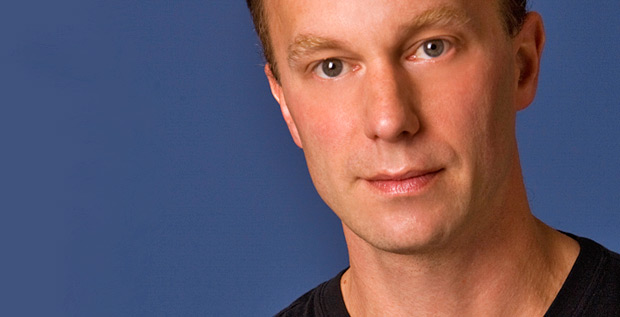
© Angela Sterling. (Click image for larger version)
He looked exactly the same – boyish face, taut body and friendly smile. But instead of being dressed in dance clothes, he was wearing russet-coloured corduroys, a black tee shirt and clunky jazz shoes that squeaked on the studio floor every time he demonstrated a turn.
Peter Boal was coaching four of his principal dancers in Balanchine’s Apollo, a ballet that he will always be associated with from his illustrious career with New York City Ballet. He watched carefully as virile Sean Orza started with the opening movements and offered, “Jump across, not up. Put your weight on the front turned-out hip.” Then Terpsichore (Carla Korbes), Polyhymnia (Lesley Rausch)and Calliope (Maria Chapman) joined in and danced with a remarkable display of togetherness – gentle easy extensions, sharp en pointe stabbings, elegant poses. The three women showed innate musicality, especially Carla Korbes whose slight body is pure dance in itself. “Feel the tension here,” Boal called out as they pulled Apollo across the sky. “Feel it”, and there was immediate evidence. Boal jumped up to demonstrate a step for Orza, and suddenly he was the young Apollo again. His arms and port de bras seared the air in his demonstration, and Orza watched intently before following the instructions. A real masterclass.
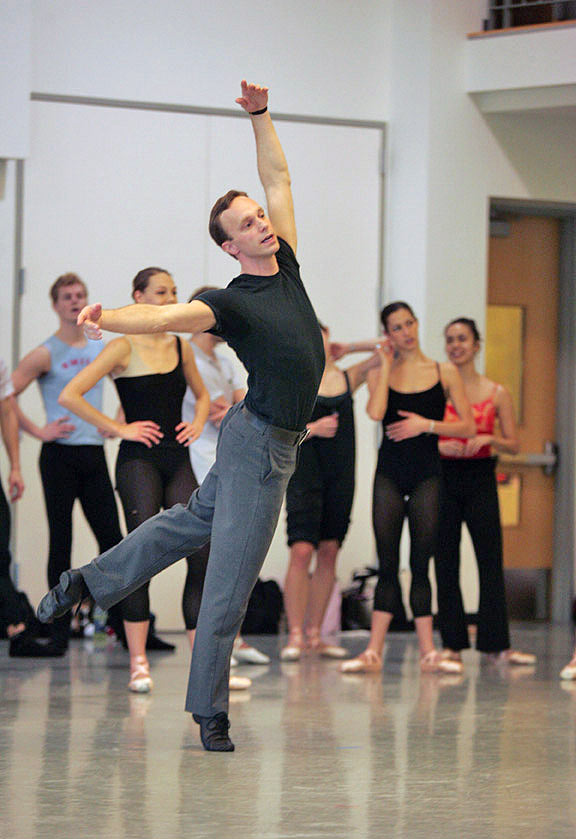
© Jerry Davis. (Click image for larger version)
“It’s been twenty five years ago since we last met”, Peter Boal reminded me. “It was in Roubaix, (northern France) when I was dancing with Ballet du Nord and you had come to review.” And he was right. We were both there at the invitation of the late Alfonso Cata, director of the company, a man who had worked with Balanchine and been responsible for bringing many of the great master’s works over to Europe. Boal had taken leave from NYCB and was spending three months in France. So when we met up again in Seattle, in his airy office at the impressive Pacific Northwest Ballet School building, there was plenty to catch up.
With his great knowledge of Balanchine works during his years as a highly-admired dancer and member of New York City Ballet, did he have much contact with the revered choreographer and founder of City Ballet?
“Alas no, I never really knew him though I worked with him when I was a child and danced the Nutcracker Prince in a school production. Later, when I was an apprentice with the company, he was already in hospital. In fact, I joined the company on the day that he died. It was miserable. Everyone was wondering, ‘would ballet go on? Would we go on?’ Not the best atmosphere for my first day of work!”

© Lindsay Thomas. (Click image for larger version)
Boal was born in Bedford, New York, in 1965 and began studying at the School of American Ballet at the age of nine. He joined New York City Ballet as a corps member in 1983 where, progressing to principal in 1989, he danced over forty ballets, with more than 20 created roles in his twenty-two years with the company. During this time he was also invited to guest with various international companies, including Birmingham Royal Ballet. “My grandfather came from Birmingham and once said that it would mean a lot if I danced in that city. So I did. I partnered Sandra Madgwick and Miyako Yoshida in The Nutcracker.” In 2002, while still performing at NYCB and teaching at School of American Ballet, he formed his own, highly successful chamber group, Peter Boal and Company, which revelled in works by contemporary and unknown choreographers. In 2005 he retired from NYCB to take over the helm of PNB from Kent Stowell and Francia Russell, whose 28 year tenure had put the company on the American dance map with its rep of Balanchine and classics. His faithful audiences regretted his departure, but he left them with many happy memories of his multi-styled performances of outstanding technical abilities, purity of line and ubiquitous elegance in everything he danced, especially in what seems to has become his signature piece – Balanchine’s god, Apollo.
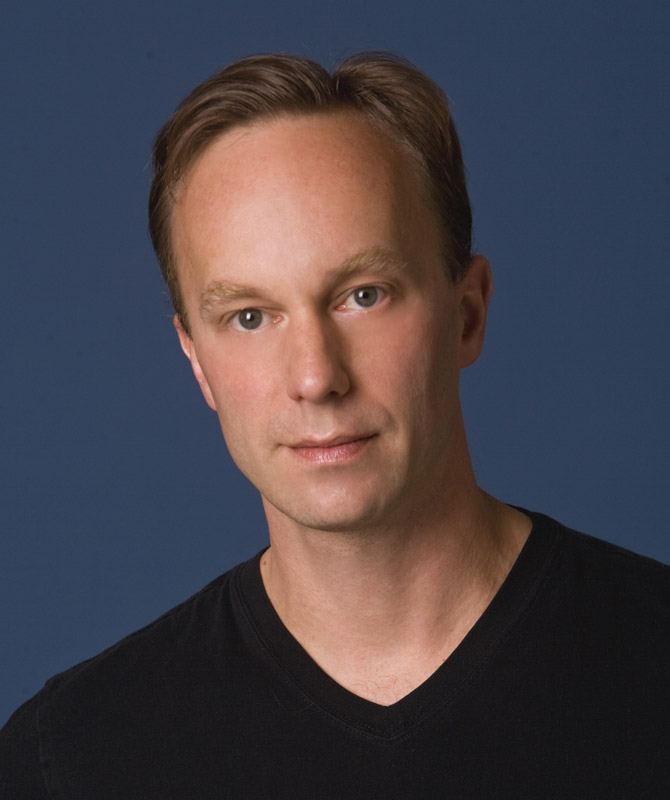
© Angela Sterling. (Click image for larger version)
His first appearance in the role was an unexpected one at the age of twenty. “I was dancing with a small touring group organized by Trisha (Patricia) McBride in Philadelphia. Ib Andersen was dancing Apollo but they hadn’t realized that he had to leave a day early and miss the last performance. So Trisha started to teach me the role. That was on Tuesday and I danced it with her on the following Sunday. I certainly had never thought about performing it so early in my career. I later worked on the role with Peter Martins – he is renowned for it. He was physically very different to me and being tall, he was a statue while I was a boy. And yes, I was there when Andris Liepa came over from the Soviet Union (with Nina Ananiashvili to dance with the company, making history as the first two Soviet dancers to be allowed officially to do so). He and I alternated in the 3rd movement of Symphony in C. And he also danced Apollo.

© Lindsay Thomas. (Click image for larger version)
“I have funny story to tell you about my final Apollo – but only because you are a mother. It was my final performance with NYCB and I was in the dressing room waiting to go on. My family was with me – my wife, two sons, daughter and nanny. The company had strewn rose petals in the hallways for me to walk on which was wonderful. We were running a little late and the intercom was calling me to the stage. At this point my daughter took herself into the bathroom –she was just out of diapers and still needed help. My wife went in, but was sent out, as was the nanny. And as the announcement pleaded for ‘Peter Boal to please come to the stage,’ my daughter demanded, ‘I want Daddy to come and wipe my bottom’! Here I was, a god, dressed in pristine white, wiping my daughter’s bum just before I made my final performance! I finally went on stage and got tremendous applause – little did they know what Apollo has just been doing!”
In 1992, Boal married fellow dancer Kelly Case in Balletin Colwall, UK. Did they choose the location because of the name, I wondered? He laughed. “No, actually my mother was born in England; she comes from the Cadbury chocolate family. However, my grandfather who worked for the company for a while, took another path and was employed by the United Nations, so that is how she came to be in America. Kelly and I wanted to do our own thing and we decided on holding our wedding at the Cadbury home, Winds Point in the Malvern Hills, which had at one time been owned by singer Jenny Lind. Of course relatives came up from London to be with us. We now have three children aged 17, 15 and 12. They all have taken ballet at some stage – my daughter got to Level 3 but is now into volleyball. Actually I wouldn’t have minded my boys dancing but not my daughter. In my mind there is too much competition and it is harder to get ahead. And there’s the body discrimination, eating disorders, eroding of self confidence etc. to contend with, which is what boys don’t have to go through.
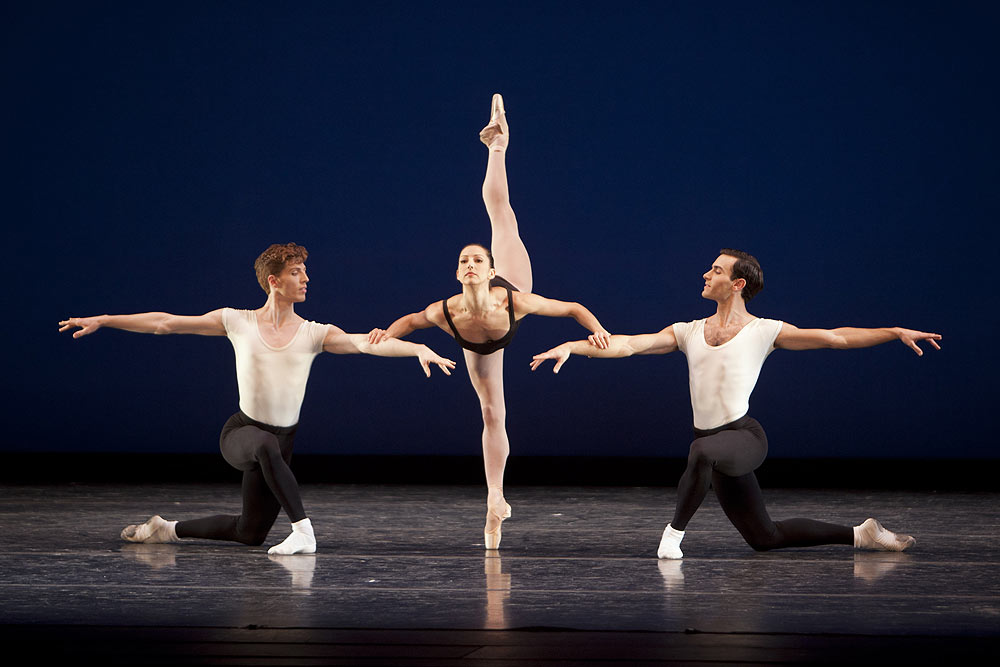
© Lindsay Thomas. (Click image for larger version)
“In the late ‘80s, I found myself getting a bit disillusioned with NYCB –the atmosphere still really hadn’t lifted since the death of Balanchine and I decided that I needed a break. I had been rushed to the top as a young prodigy and I was feeling the pressure. It was also a difficult time personally for me – there had been deaths in the family – so I thought I would go and take classes at the Dartington School of Art in Devon since I have always enjoyed art. However, just as I was planning this, Alfonso called from France saying that, since I was coming over to Europe, perhaps I would like to dance in his company. I said yes which was odd as I normally find it hard to be impulsive – everything has to be done by rule. And yet here I was, a few days later in France, dancing in a new company, learning French and going down to Paris at weekends to take class with Paris Opera Ballet. When I got to Roubaix I found John Taras setting La Sonnambula (and that’s when you and I met), and I danced that and many other ballets. I was there for three months, then took another three to travel, and on the last day of my visa, returned to the US where I took classes with Stanley Williams. Then Peter Martins came and asked if I would learn Apollo by the end of the week, and suddenly I found myself back in the company. I stayed until 2005 when I came to Seattle.”
Did he miss dancing? And had there been any thought of being a dancer-director? He laughed. “It’s horrible to be retired! After a rehearsal like today, I am sometimes tempted to think that life is so empty without dancing. But no, I knew from Day One that I wouldn’t dance any more, and that is what the Board wanted – they weren’t looking for a ‘still-dancing’ director. Actually I planned to perform just once with the company – Duo Concertante – at my opening gala, then I got injured. But I love it now when I get to do character roles such as Dr Copernicus in Coppelia and Lorenzo in Don Quixote.

© Angela Sterling. (Click image for larger version)
“We have 40 dancers in the company here in Seattle. The school allows me to use ten students for full lengths and five for mixed bills, which brings us up to around 50. I teach at PNB School twice a week and have regular meetings with the principals and know all the students from age 14 upwards. We don’t do auditions every year and only a few dancers in the company are from Seattle. We choose the dancer who feels right for this company. The dancers have twelve weeks off a year – many go and teach, some take unemployment while others will guest with other companies. Carla Korbes [DanceTabs iv], one of our principals (originally from Brazil) will go down to New Zealand to dance Swan Lake. She has been with the company since I became director and wins plaudits for everything she does. Interestingly I was her Apollo when she danced Terpsichore in Brazil for the first time at the age of 14. Soon after, she came to NYCB.
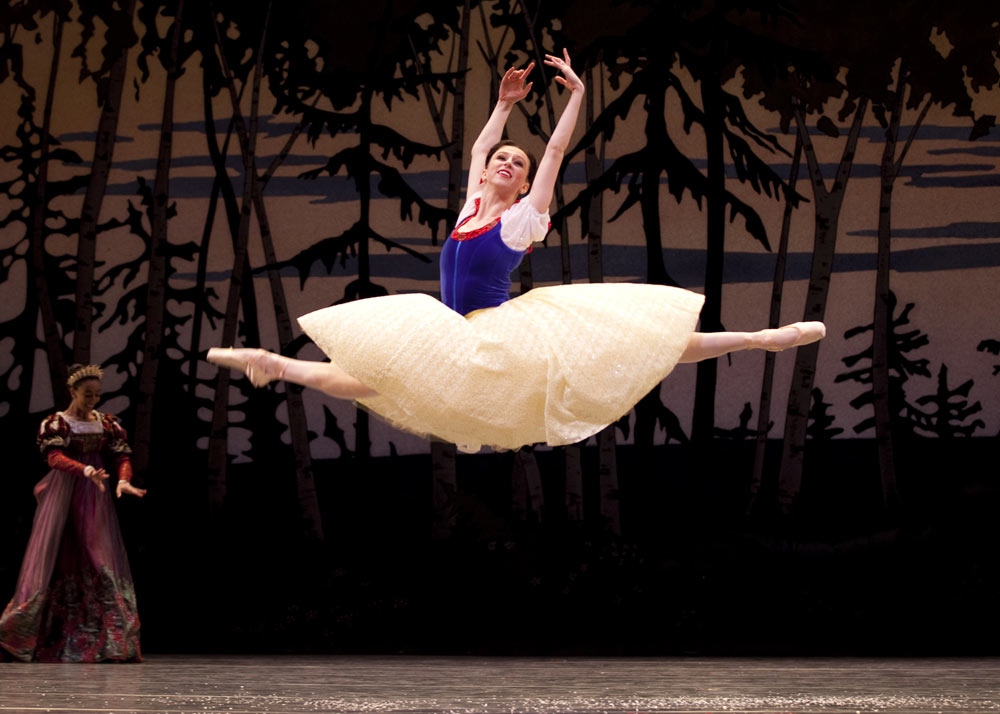
© Angela Sterling. (Click image for larger version)
“We have 40 Balanchine ballets in our rep, and while we like to champion our full lengths and our mixed reps, Balanchine is really at the heart. I was glad to see that it was such a big part of this company when I first came here. You could compare ballet to the museum world. Any curator loves collections in his museum, and is very excited about pulling in attractions and commissioning works, and having exhibitions of works by living artists. And we have a good collection of works new to the company, and we encourage new young choreographers. This means that we have mixed results with some works being very exciting, while others miss the mark. But that’s not bad – we have to experiment. We could have a good solid company which just presented all works fifty years or older, and a nice array of tried works. But then you’d have something missing – a sense of discovery, a sense of being there at this moment in time in the dance world. It’s risky, hard to discover the level of quality, especially when it’s a world premiere. I sometimes find that the more money I spend, the worse the results are! And then I get, ‘Why did you commission that?’ while others say, ‘I didn’t like it but I am so glad I saw it. And I can’t stop talking about it. I think I want to come and see it for a second time.’ I’m always interested when the dancers love it and I didn’t. You have to engage the audience but it can be hard to allocate for an audience from 15-85 years of age. You want them all there. So I set the rep with tried and true full lengths one month and mixed, often new, rep the next, throughout the year. We have 8,000 subscribers and tremendous single ticket sales. Our subscribers are fascinated by new things, and this audience gets excited by mixed reps. Sometimes they get so focused on what they are watching that they forget to applause after a solo.

© Angela Sterling. (Click image for larger version)
“We are celebrating PNB’s 40th anniversary this year and are taking 40 dancers and full orchestra to New York for the first time in 17 years, to perform Jean-Christophe Maillot’s Romeo et Juliette, and a mixed bill of Balanchine works. Yes, it was a big decision to make – to take his works back into the heart of its birthplace. But we wanted to show how we are doing. [See DanceTabs reviews by Marina Harss: Balanchine, R&J] We also have tours to Spoleto, Victoria and Las Vegas, and home celebrations consist of six world premieres. and some of our past dancers are returning for guest appearances.
“Our family life style is much quieter than in New York. The community is smaller but it really prizes itself on its cultural institutions. The Board warmly welcomed us into the neighbourhood and its social workings. Everyone looked out for us when we arrived. It proved a wonderful transition and we haven’t regretted a day of it. There’s a regional pride here and the Seattle people are very proud of their ballet company. When I came for the first time to look at the company, I was amazed to find so many of my former SAB students in the studio. In fact, all but one of the male corps de ballet had been my students. I was impressed by the company and by Seattle and turned in my application at the end of my visit.”
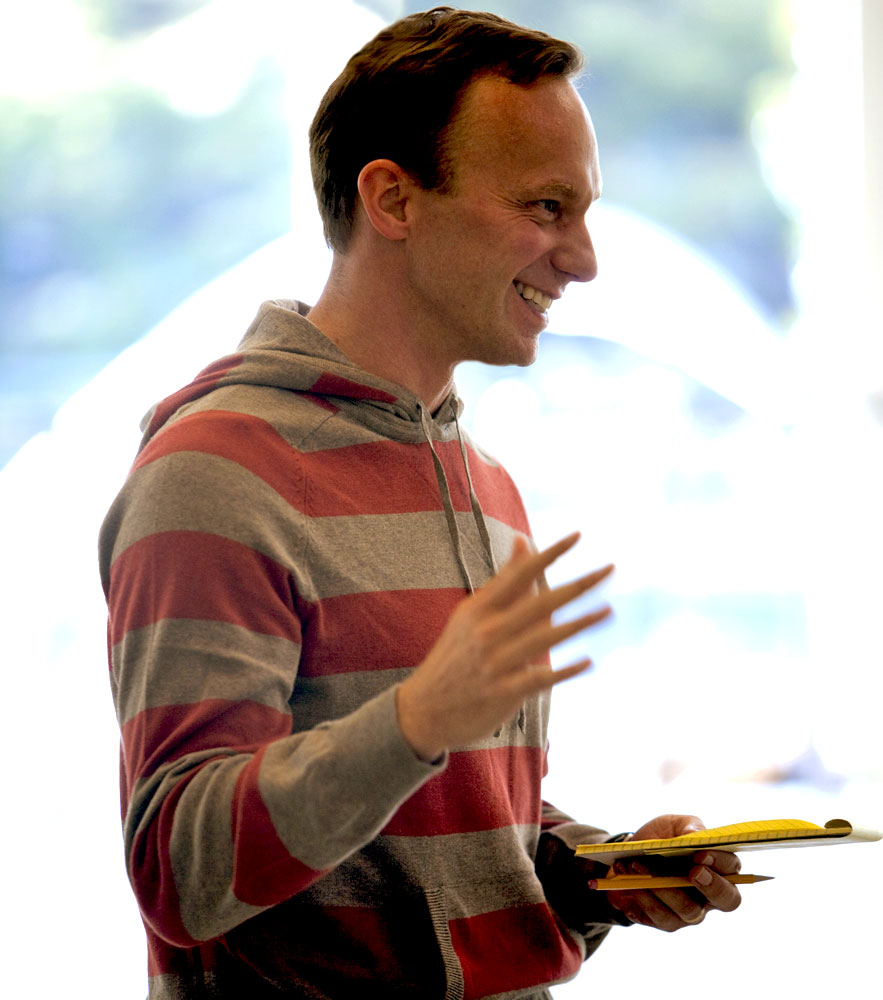
© Angela Sterling. (Click image for larger version)
So how long does he see himself staying on the far side of America? “Well, I am just about to sign another six year contract,” he grinned happily, and then joked, “That should at least see my kids through college.”







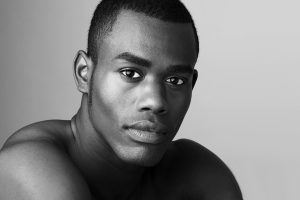




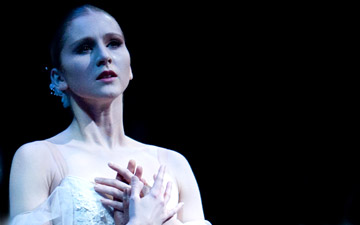


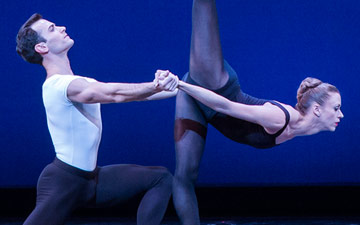

You must be logged in to post a comment.